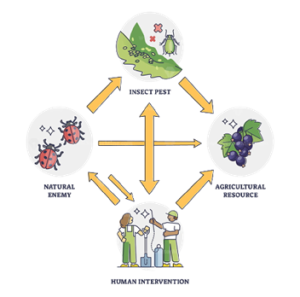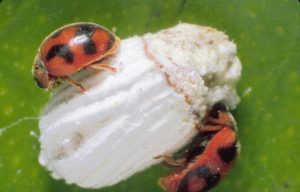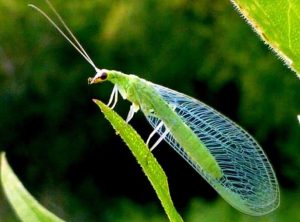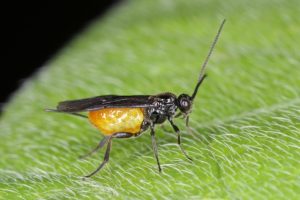Important Beneficial Insects as Natural Enemies of Crop Pests

This post is also available in:
This post is also available in:
![]() Français (French)
Français (French) ![]() Português (Portuguese (Brazil))
Português (Portuguese (Brazil))
Use of Crop Pests’ Natural Enemies for Biological Control
What is Biological Control (BC)?

Biological control is a component of an integrated pest management strategy. It is defined as the reduction of pest populations by natural enemies and typically involves an active human role. It is nature’s own way to keep the numbers of pest organisms at low levels. Biological control is part of a greater system called integrated pest management, which is a holistic approach to managing pests. That approach combines different pest control strategies to minimize their impact while reducing the use of pesticides. The ecosystem function of biological control is estimated to have an annual value close to 400 billion U.S. dollars per year compared to the 8 billion spent on insecticides.
There are three broad and somewhat overlapping types of biological control:
Classical biological control, augmentation and conservation.
Classical biological control (BC):
Classical biological control is constantly active in all world terrestrial ecosystems on 89.5 million km2 and it is applied on about 350 million hectares on the planet, representing about 8% of the land under culture on planet earth. The benefit-to-cost ratio for classical biological control is very high and can reach up to 20-500 : 1. Most of the potential arthropod pests (95%, 100,000 arthropod species) are under natural (biological) control. In BC we are talking about regulating a pest population (insect, mite, mammal, weed, pathogen) by exotic natural enemies (parasites, predators, pathogens) that are important for this purpose. BC is the practice of importing, and releasing for establishment, natural enemies to control an introduced (exotic) pest, although it is also practiced against native insect pests. After the release, the population is established in the area and becomes part of the ecosystem.
There are many examples of successful classical biological control. One of the earliest successes was with the cottony cushion scale, a pest that was devastating the California citrus industry.
It is important to mention that classical biological control is long lasting and inexpensive.
Augmentative biological control (ABC):
Augmentative, commercial biological control is applied on 0.16 million km2, which is 0.4% of land under culture, and has a benefit-cost ratio of 2-5 : 1, which is similar to or better than chemical pest control.
Augmentative biological control is about releasing additional numbers of natural enemies when few are present to control the pests effectively. There are two different categories of augmentative biological control:
- Inoculative releases in which few natural enemies may be released at a critical time of decision and
- Inundative releases in which we release millions of natural enemies in our greenhouses.
Additionally, the cropping system may be modified to favor or augment the natural enemies. This latter practice is frequently referred to as habitat manipulation.
An example of inoculative release occurs in greenhouse production of several crops. Periodic releases of the parasitoid, Encarsia formosa, are used to control greenhouse whitefly, and the predaceous mite, Phytoseiulus persimilis, is used for control of the two-spotted spider mite. Lady beetles, lacewings, or parasitoids such as Trichogramma are frequently released in large numbers (inundative release). Habitat or environmental manipulation is another form of augmentation. This tactic involves altering the cropping system to augment or enhance the effectiveness of a natural enemy.
Conservation biological control (CoBC):
The conservation of natural enemies is probably the most important and readily available biological control practice available to growers. Natural enemies occur in all production systems, from the backyard garden to the commercial field. They are adapted to the local environment and to the target pest, and their conservation is generally simple and cost-effective.
In the conservation biological control, we are not introducing natural enemies, but we would take advantage of the natural enemies that already occurring in the ecosystems that we are in.
Lacewings, lady beetles, hover fly larvae, and parasitized aphid mummies are almost always present in aphid colonies. Fungus-infected adult flies are often common following periods of high humidity. These natural controls are important and need to be conserved and considered when making pest management decisions.
Beneficial Insects used in biological control
Beneficial insects (BI) are our teammates in this.
Beneficial Insects can be divided into predators and parasitoids.
Insect predators include:
- Coleoptera (beetles),
- Hemiptera (true bags),
- Diptera (flies, midges),
- Neuroptera (lacewings),
- Hymenoptera (wasps).
- Other organisms that are not insects like spiders or mites.
In one hand there are insect predators that can be found in all plants, including parts below the ground or next to shrubs or trees on the outskirts of our crop.
They are mostly generalists, meaning they prey in many different species of pests. They are much larger than the prey, and usually, more than one biological stage is predatory. A good example is Rodolia cardinalis (Coleoptera: Coccinelidae), as it is the first case of introducing a predator to suppress a pest.
Parasitoids:
On the other hand, there are insect parasitoids. These have immature life stages that develop in or on a single insert host. Ultimately, they are killing the host. The majority of these insects are part of the orders of Hymenoptera and Diptera. They are much more specialized than predators and much smaller than their hosts. Their advantage is that they often have much quicker life cycles and can increase in numbers much faster than the predators. Their disadvantage against predators is that they are much more susceptible to insecticides.
In the next section there are examples of beneficial insects, both predators (1-3) and parasitoids (4-6):
1.Rodolia cardinalis (Coleoptera: Coccinellidae)
 It was the first case of successful classic biological control. It was released in California when the cottony cushion scale (Icerya purchasi) was found in Citrus crops in California. The infestations were so severe that the citrus growers in California were pulling out their trees and burning them. The arrival of Rodolia cardinalis saved citrus crops in California. So, Rodolia cardinalis nowadays is a control agent met in almost every part of the world, from California to Europe, to India and Asia.
It was the first case of successful classic biological control. It was released in California when the cottony cushion scale (Icerya purchasi) was found in Citrus crops in California. The infestations were so severe that the citrus growers in California were pulling out their trees and burning them. The arrival of Rodolia cardinalis saved citrus crops in California. So, Rodolia cardinalis nowadays is a control agent met in almost every part of the world, from California to Europe, to India and Asia.
2. Mirids (Hemiptera: Miridae)
They are known to protect crops by praying on other harmful insects such as aphids, spider mites, thrips, and Tuta absoluta (tomato leafminer). This family of insects includes several species of plant bugs. One of them is Nesidiocoris tenuis (tomato bug), which has been found to be beneficial in reducing Tuta absoluta populations in crops in laboratory studies and trials.
 Another well-known is Macrolophus pygmaeus (predatory bug). Its presence can induce the release of some volatiles from the plant, attracting other predators and parasitoids that feed on the same herbivores. This induction of the volatiles comes from the Macrolofus pygmeus feeding upon the plant. Those Mirids are zoophytophagous, meaning they can feed upon the pest, but in the lack of it, they can keep on feeding and surviving on the crop by feeding upon our plants.
Another well-known is Macrolophus pygmaeus (predatory bug). Its presence can induce the release of some volatiles from the plant, attracting other predators and parasitoids that feed on the same herbivores. This induction of the volatiles comes from the Macrolofus pygmeus feeding upon the plant. Those Mirids are zoophytophagous, meaning they can feed upon the pest, but in the lack of it, they can keep on feeding and surviving on the crop by feeding upon our plants.
3. Lacewings (Neuroptera)
 Lacewings are common in the fields as they can be found almost everywhere, from forests to open fields. All of their species are predacious on a variety of insects, including aphids, mites, whiteflies, thrips, or even caterpillars which can cause damage to crop. Their larvae have very strong mandibles to capture and consume their prey. The release of lacewings, it’s crucial to come in the proper time. So, it is advised to consult with a biological control company to determine the appropriate numbers of lacewings because they’re not yet defined the optimal numbers for each one.
Lacewings are common in the fields as they can be found almost everywhere, from forests to open fields. All of their species are predacious on a variety of insects, including aphids, mites, whiteflies, thrips, or even caterpillars which can cause damage to crop. Their larvae have very strong mandibles to capture and consume their prey. The release of lacewings, it’s crucial to come in the proper time. So, it is advised to consult with a biological control company to determine the appropriate numbers of lacewings because they’re not yet defined the optimal numbers for each one.
4. Encarsia formosa (Hymenoptera: Aphelinidae)
 In general, Encarsia sp. has many species used as parasitoids. It is a parasitic wasp for whiteflies that lays eggs in all premature instars except the eggs. Regularly checking for whitefly populations is crucial for Encarsia formosa to come there because the presence of the whitefly is obligatory, and its absence may be lethal. Not only because Encarsia formosa oviposits in the nymphs but also Encarsia formosa adults feed upon the nymphs. It is crucial to avoid using chemical treatments while Encarsia formosa is on the field. Usually, they are used for undercover vegetable crops such as cumbers, tomatoes, peppers, and eggplants.
In general, Encarsia sp. has many species used as parasitoids. It is a parasitic wasp for whiteflies that lays eggs in all premature instars except the eggs. Regularly checking for whitefly populations is crucial for Encarsia formosa to come there because the presence of the whitefly is obligatory, and its absence may be lethal. Not only because Encarsia formosa oviposits in the nymphs but also Encarsia formosa adults feed upon the nymphs. It is crucial to avoid using chemical treatments while Encarsia formosa is on the field. Usually, they are used for undercover vegetable crops such as cumbers, tomatoes, peppers, and eggplants.
Additionally, citrus orchards are vulnerable to whiteflies attacks like Trialeurodes vaporariorum (greenhouse whitefly) or Bemisia tabaci (silverleaf whitefly). In these occasions, Encarsia formosa can suppress their populations. We can also inoculate a new population for another orchard. This can be succeeded by taking some branches with parasitized whitefly nymphs and bringing them into the crop.
5. Trichogramma spp (Hymenoptera: Trichogrammatidae)
 Trichogrammatidae is a great family of about 200 species, of tiny wasps, all of which are parasitoids of eggs. They were used for the first time in Russia in 1920. Since 1970 they have been used regularly in classical & biological control, specifically for greenhouse insect pests. Using diffused or indirect light sources is advised because they are not so active in intense lighting. Additionally, they are susceptible to many pesticides. Trichogrammatidae larvae feed on the pest insect eggs in the plant tissue, effectively controlling the pest population. Such pests are usually moths, laying their eggs inside the plants like Tuta absoluta or Helicoverpa zea (cotton earworm). They are mostly used in grain crops, tomato crops cotton crops much less in orchards.
Trichogrammatidae is a great family of about 200 species, of tiny wasps, all of which are parasitoids of eggs. They were used for the first time in Russia in 1920. Since 1970 they have been used regularly in classical & biological control, specifically for greenhouse insect pests. Using diffused or indirect light sources is advised because they are not so active in intense lighting. Additionally, they are susceptible to many pesticides. Trichogrammatidae larvae feed on the pest insect eggs in the plant tissue, effectively controlling the pest population. Such pests are usually moths, laying their eggs inside the plants like Tuta absoluta or Helicoverpa zea (cotton earworm). They are mostly used in grain crops, tomato crops cotton crops much less in orchards.
6. Anagyrus lopezi (Hymenoptera: Encyrtidae)
 Common name: Cassava mealybug parasite. Anagyrus lopezi can be the Rodolia cardinalis of Africa. Anagyrus lopezi, is a monophagous species that feeds just upon the cassava mealybug. In the early 80s in 1980 in Nigeria, there was a significant problem with the cassava mealybug, so Anagyrus lopezi was introduced and saved the growers’ cassava crops.
Common name: Cassava mealybug parasite. Anagyrus lopezi can be the Rodolia cardinalis of Africa. Anagyrus lopezi, is a monophagous species that feeds just upon the cassava mealybug. In the early 80s in 1980 in Nigeria, there was a significant problem with the cassava mealybug, so Anagyrus lopezi was introduced and saved the growers’ cassava crops.
Weed Control with Beneficial Insects
Insects, in terms of biological control, are not just used to suppress other pests; they are also occasionally used to suppress weeds. Several genera have been used with mostly known the flea beetles of Phyllotreta spp., Listronotus spp., Cactoblastis cactorum, Ophiomyia spp., Cecodomyyidae spp. These species thrive in the habitat occupied by the weed and are used in combination with other control species.
The problem here is that we have to perform many more tests, because their application requires monitoring and evaluation. That is because we want to avoid introducing new species in an ecosystem that may cause unintended harm to non-target species.
Further reading








































































